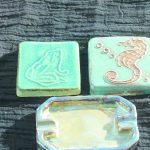A history of Pewabic pottery in the U.P.

A Pewabic tile fireplace at the Detroit Public Library.
- A Pewabic tile fireplace at the Detroit Public Library.
- Pewabic ceramics from the Marquette Regional History Center’s permanent collection.
Mary Chase Perry (1867-1961) was the daughter of a physician for the miners at the Pewabic, Quincy, and Franklin copper mines in Hancock. They took walks together and discovered the red clays and other minerals native to the region. Mary made many little clay figures which a local brickyard agreed to fire. When Mary was ten, Dr. Perry was killed by an unknown assailant. The family moved to Ann Arbor and later to Detroit where her brother started a dental practice.
Mary continued artistic interests and enrolled at the Art Academy of Cincinnati. Fascinated by china painting, much in vogue at the turn of the century, Mary returned to Detroit to open a china painting studio. One of Detroit’s major supporters of the Arts and Crafts Movement was her neighbor, a dentist, Horace Caulkins. His Revelation Kiln revolutionized the methods for firing dental materials, glass and enamels, and decorated china.
With Caulkin’s kiln and financial support, Mary began to experiment with china glazes in what was called the backyard “Stable Workshop” and came up with a special green glaze for bowls and jars. On a chance, she took samples to a Chicago connoisseur who promptly ordered “$1,000 of whatever you can make.” Mary was elated! Thus in 1903 Pewabic pottery was founded. She said “I was born in the Upper Peninsula and there was a mine called Pewabic nearby.” Pewabic derives from the Ojibwe word for iron.
The ceramic expert and connoisseur Charles Lang Freer encouraged the new pottery and gave Mary Chase Perry and her partner Horace J. Caulkins access to his important collection of Asian and Near Eastern ceramics. Freer made a fortune as the finance man for a Detroit railroad car manufacturer. At his urging Mary began to experiment with iridescent glaze effects. It was not until 1909 that she succeeded in a glaze formula that displayed her famous iridescent, opalescent effect. The first piece was called “First Iridescent 1909.”

Pewabic ceramics from the Marquette Regional History Center’s permanent collection.
The iridescent glaze formula has been called one of her greatest achievements, was never shared, and was lost with her death. “Once you discover something on your own, it really belongs to you. You can’t discover anything important by copying.”
Meanwhile, William B. Stratton and his partner Frank D. Baldwin became influential architects in Detroit in the early part of the century. Their firm was the first in Michigan to be headed solely by architects trained in American Schools. The firm had many significant commissions in the Detroit area. Mary Chase Perry married Stratton in 1918. Stratton encouraged Mary to make surround tiles for a fireplace in a new building he was designing.
This commission led to a second Pewabic Pottery focus, the production of tiles. Her tiles were preferred by many architects and this gave her financial success. Commissions were filled for tile floors, fountains, and other architectural ornamentation for businesses, schools, libraries, museums, churches, mausoleums, memorials, and hundreds of private homes.
Mary Chase Perry’s major commissions included the Detroit Public Library, the Nebraska State Capitol in Lincoln, and Herald Square in New York City. Projects in the Upper Peninsula included Houghton High School, Ishpeming Public Schools, Negaunee Public Schools, St. Peter Cathedral in Marquette, and Michigan Technological University. Pewabic art pottery is in many museums and private collections, most notably the Freer Gallery of the Smithsonian Institute in Washington D.C., and the Louvre in Paris.
The Pewabic Pottery company maintains a museum and educational center in Detroit. It is the oldest art pottery in continuous production in America.
The Arts and Crafts Movement was strong in Michigan. Many examples of Pewabic Pottery are in private homes. There are probably existing examples in the Upper Peninsula. Do you have Pewabic Pottery tiles or ceramic wares in your house? If so, contact the authors at the History Center.
Come see an important local example of Pewabic Pottery and learn about the history of St. Peter Cathedral at a special lecture by Marquette Regional History Center member Dr. Russ Magnaghi. His presentation about the Cathedral’s beautification after the 1935 fire will accompany an Italian music concert. This event at St. Peter Cathedral Friday from 7:30 p.m.-9 p.m. is free to the public, donations welcome.







